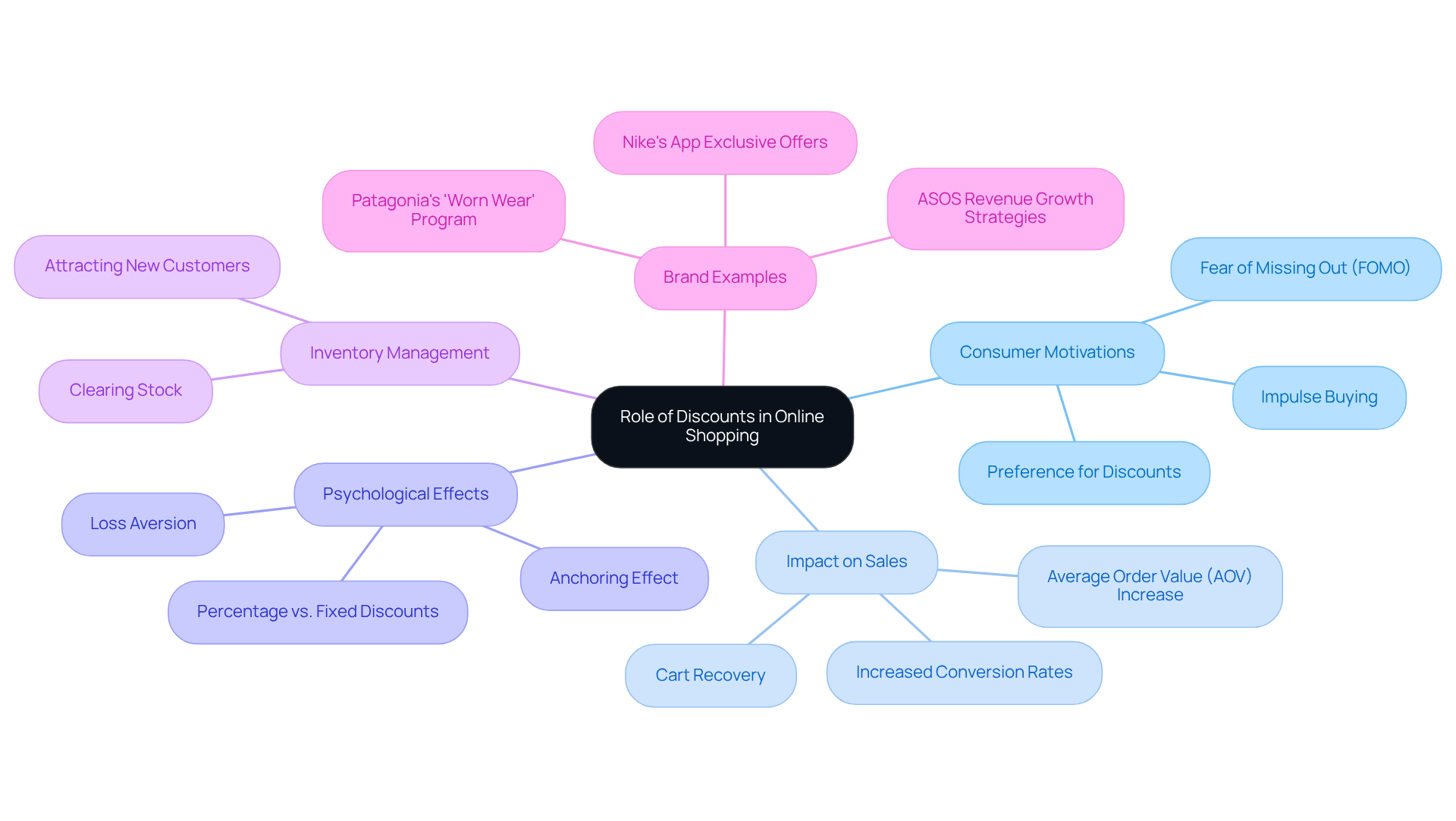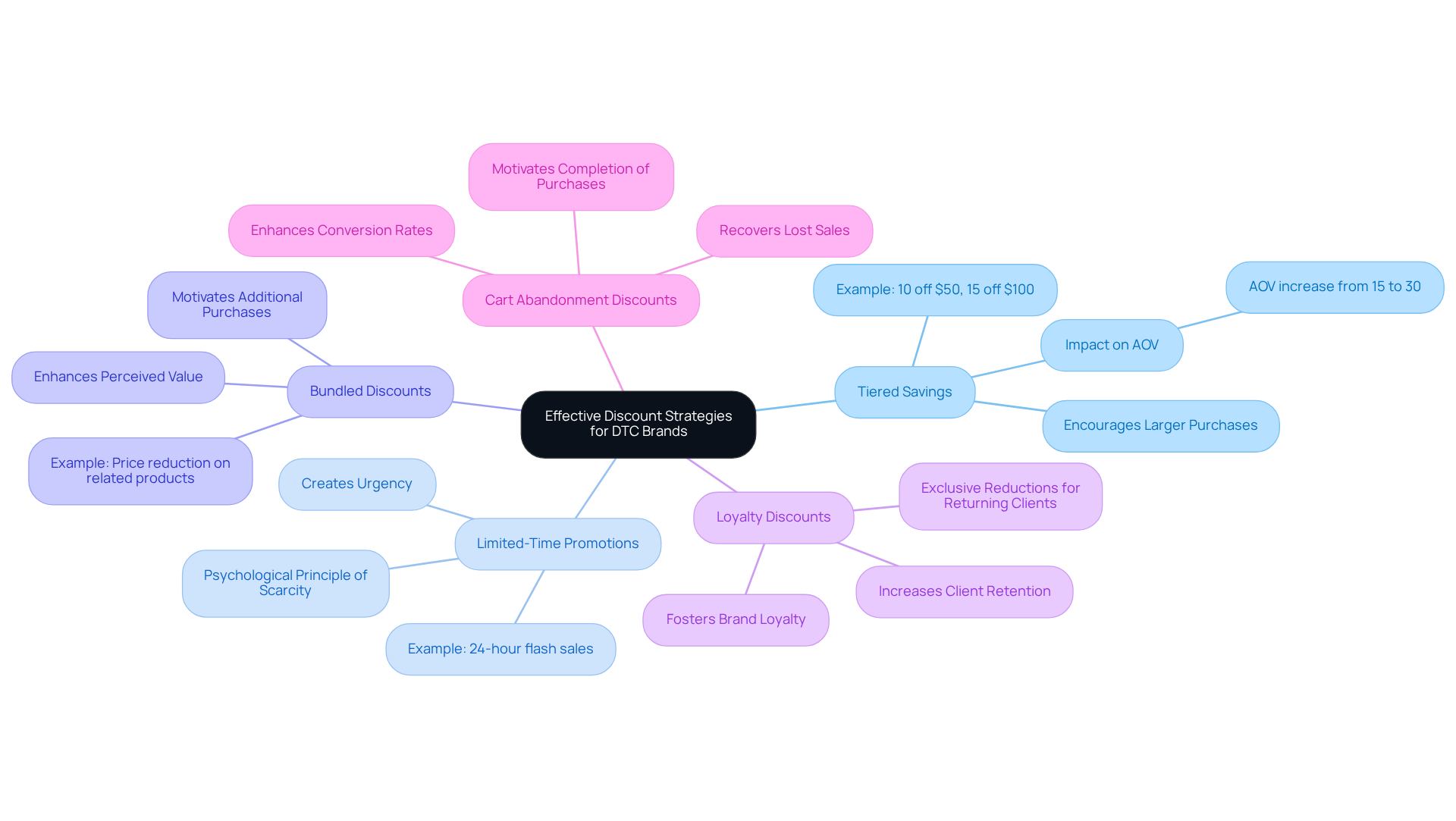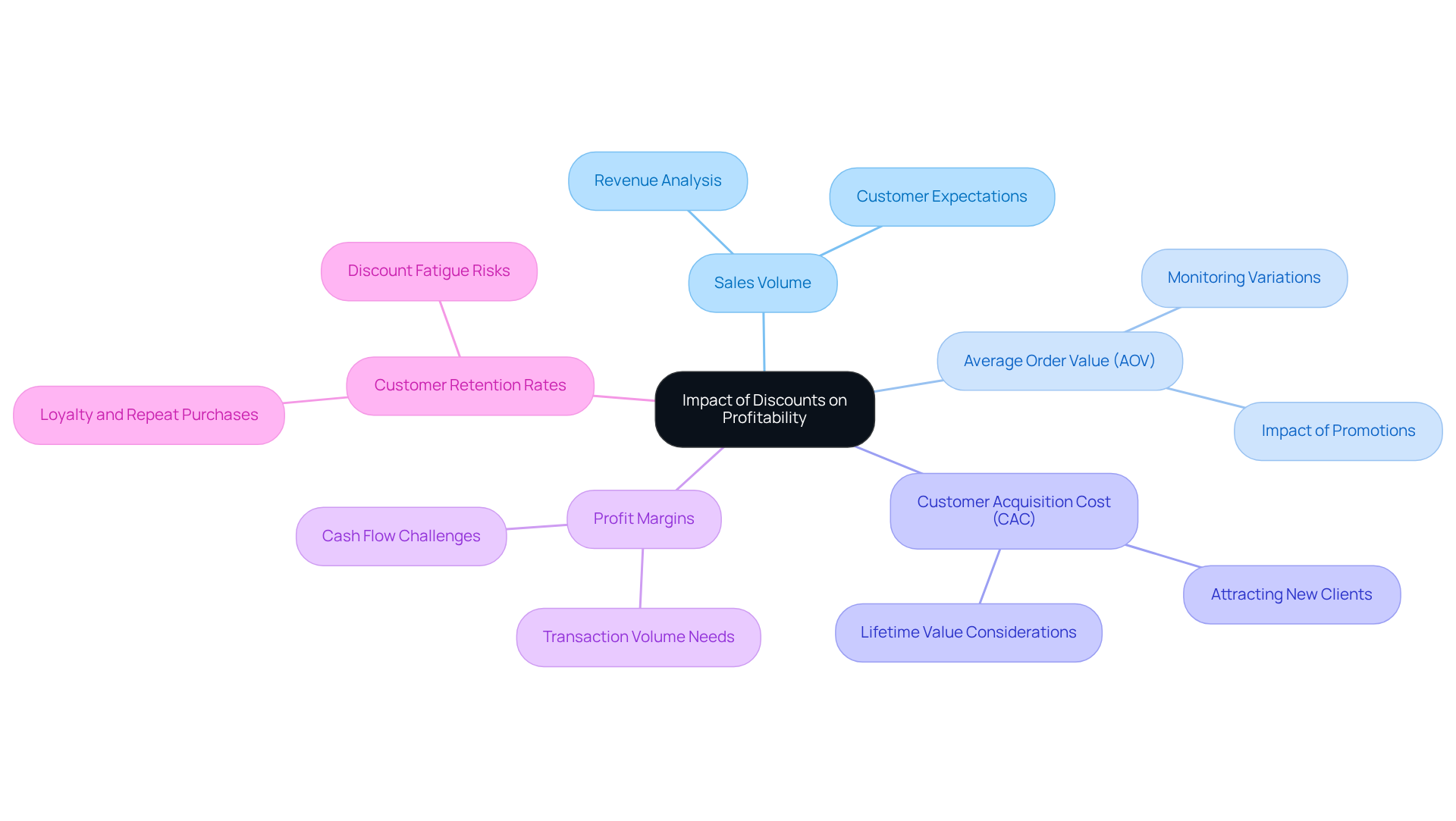
Overview
The article presents three pivotal strategies for leveraging discounts in online shopping:
- Tiered savings
- Limited-time promotions
- Exclusive offers for returning customers
These strategies are underpinned by compelling evidence indicating their effectiveness in enhancing average order values, driving immediate sales through a sense of urgency, and cultivating customer loyalty. Ultimately, these approaches contribute significantly to the long-term profitability of direct-to-consumer brands.
Introduction
Discounts have emerged as a cornerstone of online shopping, profoundly shaping consumer behavior and influencing purchasing decisions. By effectively leveraging these price reductions, brands can drive increased sales, foster enhanced customer loyalty, and boost profitability. Yet, the challenge remains: how can brands implement discount strategies that entice consumers while safeguarding their long-term financial health? This pivotal question demands a strategic approach, balancing immediate consumer attraction with sustainable business practices.
Understand the Role of Discounts in Online Shopping
Discounts in online shopping serve as powerful motivators, significantly influencing consumer perceptions and purchasing decisions. They create a sense of urgency, encourage impulse buying, and enhance the perceived value of products. For instance, limited-time promotions can trigger a fear of missing out (FOMO), prompting buyers to act swiftly. Studies indicate that over 60% of buyers are inclined to finalize a purchase when presented with a discount in online shopping on items left in their shopping carts, underscoring the impact of price reductions in reclaiming potentially lost sales.
Furthermore, the discount in online shopping plays a critical role in inventory management, assisting companies in clearing stock while appealing to new clients. Direct-to-consumer (DTC) brands that implement strategic price reductions, such as discount in online shopping, often observe increased client loyalty; for example, early-access price cuts as part of loyalty initiatives can elevate retention rates by 22%. This strategy not only rewards existing customers but also encourages .
The psychological impacts of a discount in online shopping are noteworthy. Percentage-based reductions are generally perceived as more appealing than fixed amounts, particularly for higher-priced items. This aligns with findings indicating that consumers are more responsive to a discount in online shopping framed in percentage terms, which can enhance their perceived value. Moreover, tailored offers adjusted to consumer behavior can yield a 31% increase in cart conversion rates, highlighting the importance of implementing discount in online shopping through data-informed strategies.
Brands such as Nike have effectively leveraged these insights by providing app-exclusive offers based on user behavior, resulting in a 20% increase in conversion rates. Such examples illustrate how understanding consumer psychology and behavior can enhance the effectiveness of pricing strategies, such as offering a discount in online shopping, ultimately boosting sales and fostering long-term customer loyalty. Parah Group, recognized as an expert in Conversion Rate Optimization, emphasizes the necessity for sustainable growth and profitability through strategic discounting, particularly by leveraging a discount in online shopping. Their proven case studies, such as a 35% increase in conversion rates for a $30M apparel company through optimized discount in online shopping strategies, demonstrate how innovative CRO strategies can amplify the effectiveness of discounts while maintaining brand integrity. However, companies must exercise caution, as excessive discount in online shopping can lead to a 15% decline in profitability over five years. By balancing these strategies, DTC companies can enhance their effectiveness in driving sales and nurturing long-term loyalty.

Implement Effective Discount Strategies for DTC Brands
To implement effective discount strategies, DTC brands must adopt several key approaches:
- Tiered Savings: By encouraging larger purchases through incremental reductions based on spending thresholds—such as 10% off orders over $50 and 15% off orders over $100—brands can significantly enhance their (AOV). This strategy motivates customers to increase their spending to achieve the next discount in online shopping tier. For instance, a retailer that introduced tiered price reductions saw AOV for orders between $50 and $70 increase from 15% to 30%.
- Limited-Time Promotions: Creating urgency through flash events or time-sensitive promotions can effectively drive immediate traffic and conversions by offering a discount in online shopping. A well-timed 24-hour promotion leverages the psychological principle of scarcity, prompting shoppers to act quickly. Brands that effectively utilize limited-time offers often experience notable spikes in sales, as consumers rush to capitalize on the discount in online shopping before it expires.
- Offering a discount in online shopping for bundled products enhances perceived value and motivates buyers to purchase more than they initially planned. For example, providing a price reduction on a collection of related products not only boosts AOV but also enriches the shopping experience, leading to greater customer satisfaction.
- Offering a discount in online shopping to returning clients with exclusive reductions or early access to promotions fosters brand loyalty and encourages repeat purchases, which are essential for long-term profitability. Brands implementing loyalty programs frequently observe significant increases in client retention and overall revenue.
- Offering a discount in online shopping for individuals who abandon their carts can help recover potentially lost sales and convert hesitant buyers into clients. By offering a small incentive, companies effectively motivate customers to complete their purchases, thereby enhancing conversion rates and AOV.

Measure the Impact of Discounts on Profitability
To effectively measure the impact of discounts on profitability, DTC brands must track the following metrics:
- Sales Volume: Examining revenue data before, during, and after promotional campaigns is essential to identify the increase in sales volume linked to the discount in online shopping. This analysis is crucial for evaluating the effectiveness of the pricing strategy in boosting revenue. Brands that rely heavily on promotions may find that while they attract customers, they risk conditioning them to expect lower prices, potentially diminishing full-price sales over time.
- Average Order Value (AOV): Monitoring variations in AOV during promotional periods is vital. An effective pricing strategy should ideally lead to an increase in AOV, indicating that customers are purchasing more items. However, frequent promotions can result in a lower AOV during sales phases, impacting long-term business performance. For instance, brands that introduce lower-priced product lines without discounts can stimulate initial purchases while maintaining a higher AOV.
- Customer Acquisition Cost (CAC): Evaluating how price reductions affect CAC is essential. While a discount in online shopping can attract new clients, it is crucial to ensure that the cost of acquiring these clients does not exceed their lifetime value. Brands should exercise caution, as customers whose initial purchase is motivated by a price reduction are 50% less likely to make a subsequent purchase, underscoring the necessity for a balanced strategy.
- Profit Margins: Analyzing the impact of discounts on profit margins is critical. For example, maintaining profitability may require a significant increase in transaction volume when offering a 10% discount in online shopping. Brands should assess whether the surge in sales compensates for the reduced margins, as excessive discounting can erode profit margins and lead to cash flow challenges. Moreover, frequent discounting can diminish the perceived value of a brand or product, with potential long-term consequences.
- Customer Retention Rates: Assessing whether price reductions lead to higher retention rates is important. If customers return for additional purchases after receiving discounts, it suggests that the approach fosters loyalty and sustained profitability. However, loyalty based solely on price reductions is fragile; emotional connections and unique experiences are vital for cultivating genuine customer loyalty. Additionally, brands should be wary of discount fatigue, which occurs when consumers feel overwhelmed by offers, resulting in decreased responsiveness to promotions. To mitigate this, can encourage repeat business while maintaining stable pricing.

Conclusion
The effective use of discounts in online shopping stands as a pivotal strategy for driving sales and cultivating customer loyalty. By grasping the psychological impact of discounts and implementing targeted pricing strategies, brands can markedly enhance their appeal to consumers. This method not only stimulates immediate purchases but also lays a solid foundation for enduring relationships with customers.
Key strategies—such as tiered savings, limited-time promotions, and exclusive discounts for returning clients—have demonstrated effectiveness in elevating average order values and conversion rates. Furthermore, it is essential to measure the impact of discounts on profitability through metrics like sales volume, average order value, and customer acquisition costs to maintain a healthy balance between attracting customers and safeguarding profit margins.
In conclusion, the importance of discounts in the online retail landscape is profound. Brands must adeptly navigate the delicate balance between enticing consumers with price reductions and ensuring sustainable profitability. By adopting data-informed discount strategies and continuously analyzing their effectiveness, companies can not only boost immediate sales but also foster a loyal customer base that appreciates their offerings beyond mere price. Embracing these best practices will position brands for success in the competitive online marketplace of 2025 and beyond.
Frequently Asked Questions
What role do discounts play in online shopping?
Discounts serve as powerful motivators that influence consumer perceptions and purchasing decisions, creating urgency, encouraging impulse buying, and enhancing perceived product value.
How do limited-time promotions affect consumer behavior?
Limited-time promotions can trigger a fear of missing out (FOMO), prompting buyers to act quickly and finalize their purchases, especially on items left in their shopping carts.
What impact do discounts have on inventory management?
Discounts assist companies in clearing stock while attracting new clients, making them an important tool for inventory management.
How do discounts influence customer loyalty?
Strategic price reductions, such as early-access discounts for loyal customers, can significantly increase client retention rates, with some brands observing a 22% rise in repeat purchases.
Are percentage-based discounts more effective than fixed amount discounts?
Yes, percentage-based reductions are generally perceived as more appealing, especially for higher-priced items, as they enhance the perceived value of the discount.
How can tailored offers impact cart conversion rates?
Tailored offers that are adjusted to consumer behavior can lead to a 31% increase in cart conversion rates by making discounts more relevant to individual customers.
Can you provide an example of a brand effectively using discounts?
Nike has successfully used app-exclusive offers based on user behavior, resulting in a 20% increase in conversion rates.
What are the potential risks of excessive discounting?
Excessive discounting can lead to a 15% decline in profitability over five years, highlighting the need for a balanced approach to discount strategies.
How can companies ensure sustainable growth through discounts?
Companies can achieve sustainable growth and profitability by leveraging strategic discounting, informed by data and consumer behavior, to enhance sales and maintain brand integrity.
FAQs











